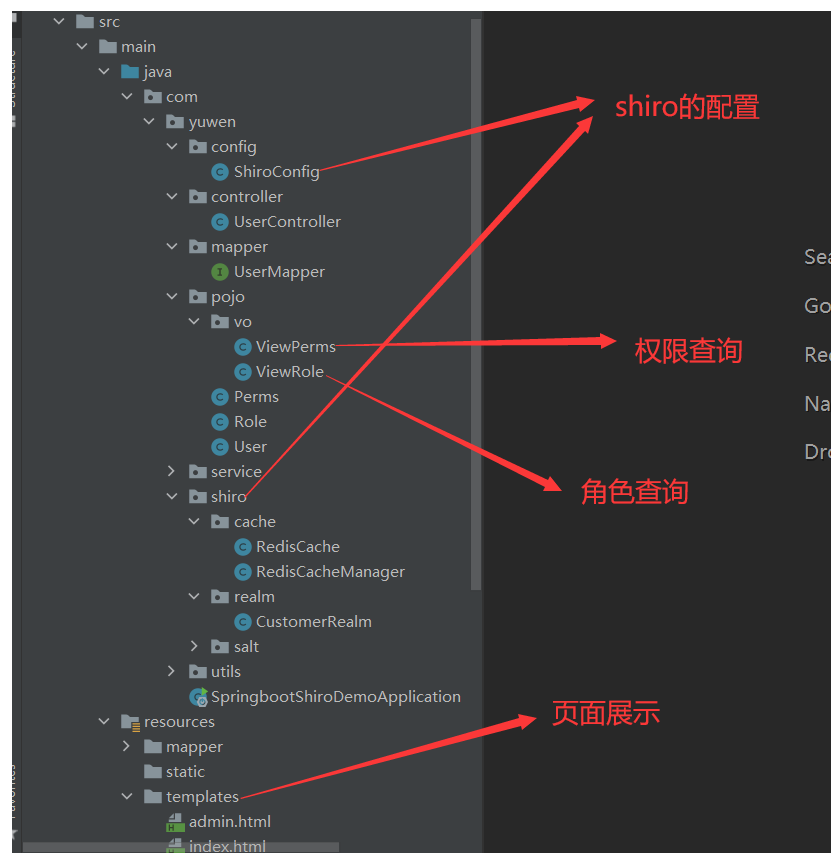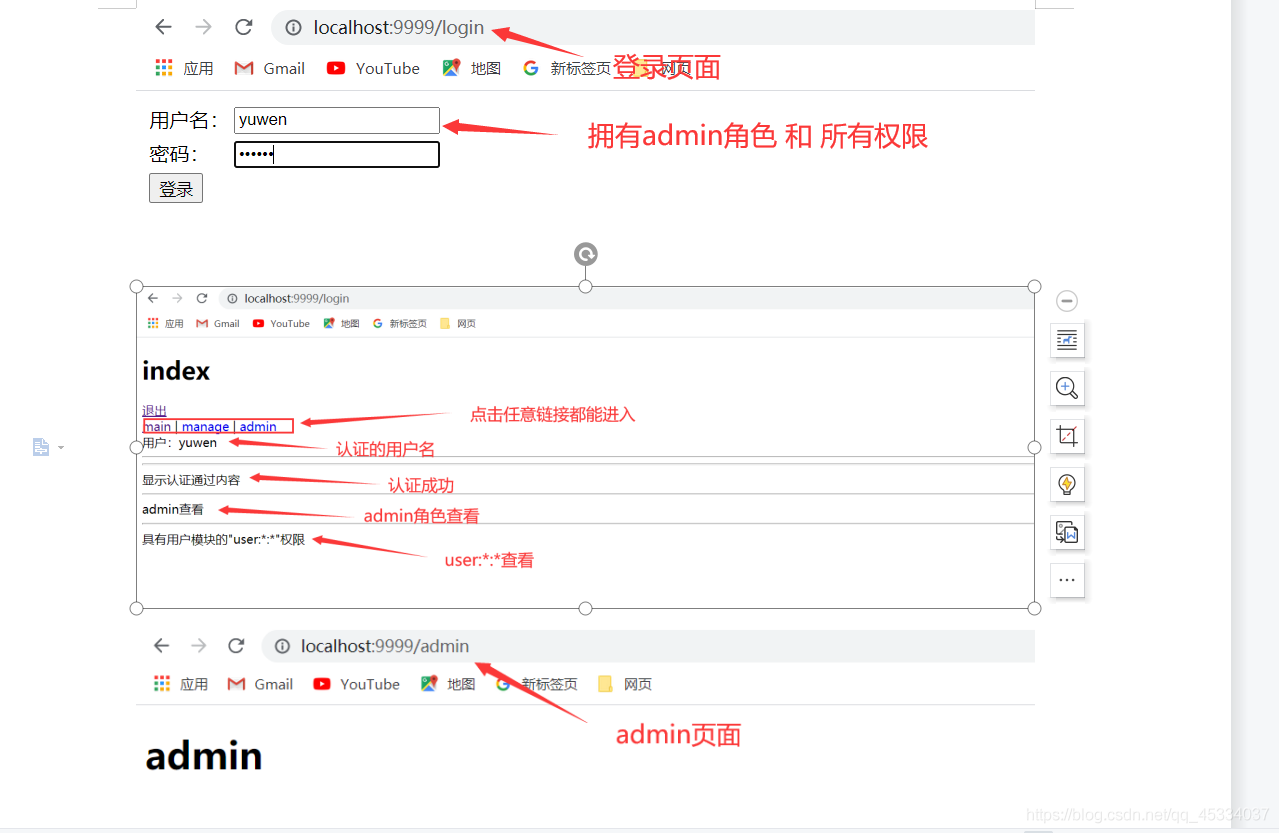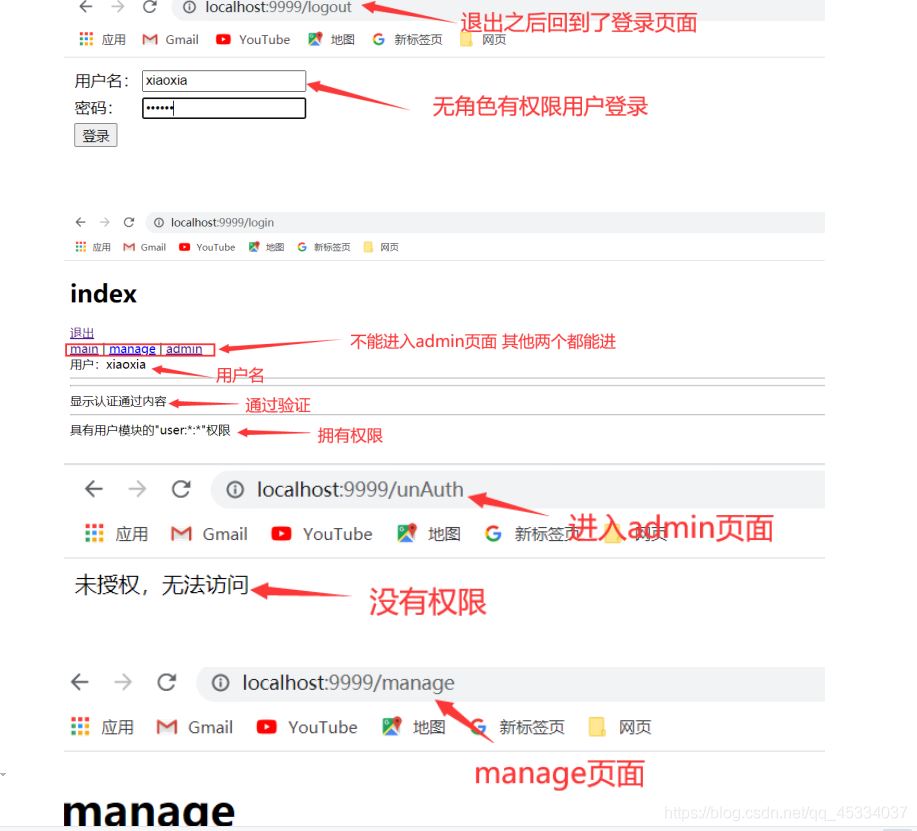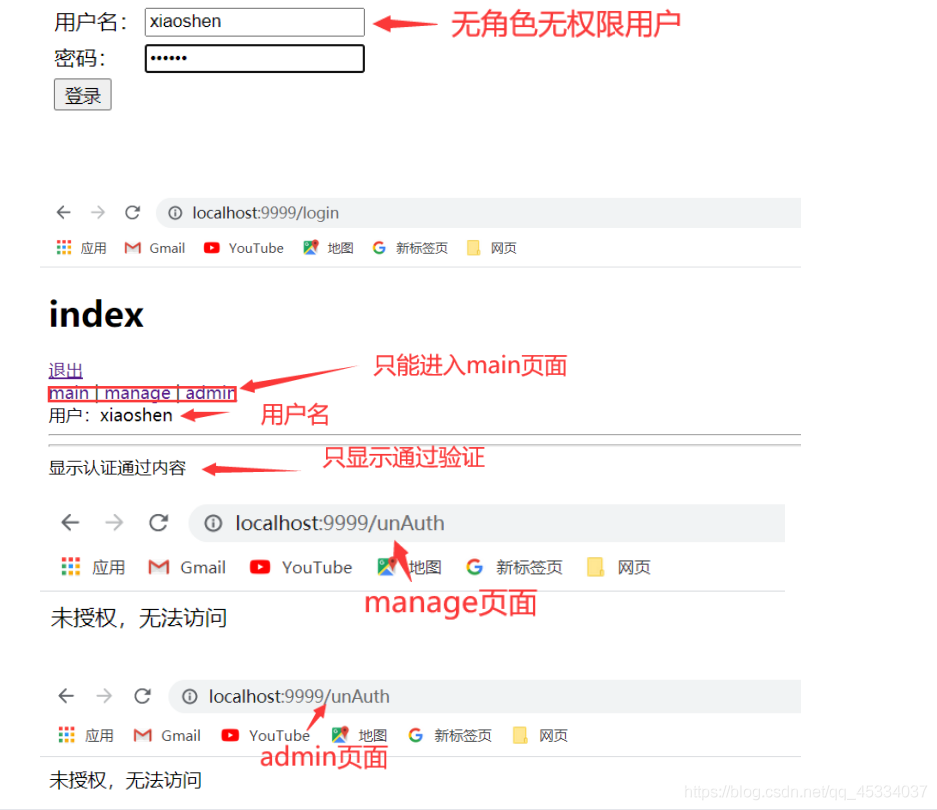SpringBoot怎么整合Shiro实现权限控制
1、SpringBoot整合Shiro
Apache Shiro是一个强大且易用的Java安全框架,执行身份验证、授权、密码和会话管理。
1.1、shiro简介
shiro有个核心组件,分别为Subject、SecurityManager和Realms
Subject:相当于当前操作的”用户“,这个用户不一定是一个具体的人,是一个抽象的概念,表明的是和当前程序进行交互的任何东西,例如爬虫、脚本、等等。所有的Subject都绑定到SecurityManager上,与 Subject 的所有交互都会委托给 SecurityManager;可以把 Subject 认为是一个门面;SecurityManager 才是实际的执行者。
SecurityManager:这个是shiro框架的核心,所有与安全相关的操作都会与它进行交互,它管理者所有的Subject。
Realms:充当了Shiro与应用安全数据间的”桥梁“,当对用户执行认证(登录)和授权(访问控制)验证时,SecurityManager 需要从 Realm 获取相应的用户进行比较以确定用户身份是否合法;也需要从 Realm 得到用户相应的角色 / 权限进行验证用户是否能进行操作。
1.2、代码的具体实现
1.2.1、Maven的配置
<!--shiro-->
<dependency>
<groupId>org.apache.shiro</groupId>
<artifactId>shiro-spring-boot-starter</artifactId>
<version>1.7.1</version>
</dependency>
<!--shiro整合thymeleaf-->
<dependency>
<groupId>com.github.theborakompanioni</groupId>
<artifactId>thymeleaf-extras-shiro</artifactId>
<version>2.0.0</version>
</dependency>
<!--shiro缓存-->
<dependency>
<groupId>org.apache.shiro</groupId>
<artifactId>shiro-ehcache</artifactId>
<version>1.7.1</version>
</dependency>shiro默认是与jsp进行使用的,而这里是shiro整合thymeleaf所有要导入shiro整合thymeleaf的jar包
1.2.2、整合需要实现的类
一般来说整合只需要完成两个类的实现即可
一个是 ShiroConfig 一个是 CustomerRealm
如果需要添加shiro缓存并且不是自带的缓存而是redis缓存还需要进行另外两个类的编写
一个是 RedisCache 一个是 RedisCacheManager
1.2.3、项目结构

1.2.4、ShiroConfig的实现
未加shiro的缓存
package com.yuwen.config;
import at.pollux.thymeleaf.shiro.dialect.ShiroDialect;
import com.yuwen.shiro.cache.RedisCacheManager;
import com.yuwen.shiro.realm.CustomerRealm;
import org.apache.shiro.authc.credential.HashedCredentialsMatcher;
import org.apache.shiro.realm.Realm;
import org.apache.shiro.spring.web.ShiroFilterFactoryBean;
import org.apache.shiro.web.mgt.DefaultWebSecurityManager;
import org.springframework.beans.factory.annotation.Qualifier;
import org.springframework.context.annotation.Bean;
import org.springframework.context.annotation.Configuration;
import java.util.HashMap;
import java.util.Map;
@Configuration
public class ShiroConfig {
//让页面shiro标签生效
@Bean
public ShiroDialect shiroDialect(){
return new ShiroDialect();
}
//1、创建shiroFilter 负责拦截所有请求
@Bean
public ShiroFilterFactoryBean shiroFilterFactoryBean(DefaultWebSecurityManager defaultWebSecurityManager){
ShiroFilterFactoryBean factoryBean = new ShiroFilterFactoryBean();
//给filter设置安全管理
factoryBean.setSecurityManager(defaultWebSecurityManager);
//配置系统的受限资源
//配置系统公共资源 全部都能访问的设置anon
Map<String,String> map = new HashMap<>();
map.put("/main","authc");//请求这个资源需要认证和授权 authc表示需要认证后才能访问
map.put("/admin","roles[admin]"); //表示admin角色才能访问 roles[]表示需要什么角色才能访问
map.put("/manage","perms[user:*:*]"); //表示需要user:*:*权限才能访问 perms[]表示需要什么权限才能访问
//访问需要认证的页面如果未登录会跳转到/login路由进行登陆
factoryBean.setLoginUrl("/login");
//访问未授权页面会自动跳转到/unAuth路由
factoryBean.setUnauthorizedUrl("/unAuth");
factoryBean.setFilterChainDefinitionMap(map);
return factoryBean;
}
//2、创建安全管理器
@Bean
public DefaultWebSecurityManager defaultWebSecurityManager(@Qualifier("getRealm") Realm realm){
DefaultWebSecurityManager securityManager = new DefaultWebSecurityManager();
//给安全管理器设置
securityManager.setRealm(realm);
return securityManager;
}
//3、创建自定义的realm
@Bean
public Realm getRealm(){
CustomerRealm customerRealm = new CustomerRealm();
//修改凭证校验匹配器
HashedCredentialsMatcher credentialsMatcher = new HashedCredentialsMatcher();
//设置加密算法为md5
credentialsMatcher.setHashAlgorithmName("MD5");
//设置散列次数
credentialsMatcher.setHashIterations(1024);
customerRealm.setCredentialsMatcher(credentialsMatcher);
return customerRealm;
}
}因为一般在数据库中设置明文密码不安全,所有我这里对密码进行了md5加密,我的加密方式为:密码 = 密码+盐+散列次数 而后进行MD5加密 所以这里创建自定义的realm时需要进行设置匹配器这样登录时密码才能匹配成功
1.2.5、CustomerRealm的实现
package com.yuwen.shiro.realm;
import com.yuwen.pojo.User;
import com.yuwen.pojo.vo.ViewPerms;
import com.yuwen.pojo.vo.ViewRole;
import com.yuwen.service.UserService;
import com.yuwen.shiro.salt.MyByteSource;
import org.apache.shiro.authc.AuthenticationException;
import org.apache.shiro.authc.AuthenticationInfo;
import org.apache.shiro.authc.AuthenticationToken;
import org.apache.shiro.authc.SimpleAuthenticationInfo;
import org.apache.shiro.authz.AuthorizationInfo;
import org.apache.shiro.authz.SimpleAuthorizationInfo;
import org.apache.shiro.realm.AuthorizingRealm;
import org.apache.shiro.subject.PrincipalCollection;
import org.apache.shiro.util.CollectionUtils;
import org.springframework.util.ObjectUtils;
import javax.annotation.Resource;
import java.util.List;
//自定义realm
public class CustomerRealm extends AuthorizingRealm {
@Resource
private UserService userService;
//授权
@Override
protected AuthorizationInfo doGetAuthorizationInfo(PrincipalCollection principalCollection) {
//获取身份信息
String primaryPrincipal = (String)principalCollection.getPrimaryPrincipal();
//根据主身份信息获取角色 和 权限信息
List<ViewRole> roles = userService.findRolesByUsername(primaryPrincipal);
if (!CollectionUtils.isEmpty(roles)){
SimpleAuthorizationInfo simpleAuthorizationInfo = new SimpleAuthorizationInfo();
roles.forEach(viewRole -> {
simpleAuthorizationInfo.addRole(viewRole.getName());
//权限信息
List<ViewPerms> perms = userService.findPermsByRoleId(viewRole.getName());
if (!CollectionUtils.isEmpty(perms)){
perms.forEach(viewPerms -> {
simpleAuthorizationInfo.addStringPermission(viewPerms.getPName());
});
}
});
return simpleAuthorizationInfo;
}
return null;
}
//认证
@Override
protected AuthenticationInfo doGetAuthenticationInfo(AuthenticationToken authenticationToken) throws AuthenticationException {
//获取登入的身份信息
String principal = (String) authenticationToken.getPrincipal();
User user = userService.findByUsername(principal);
if (!ObjectUtils.isEmpty(user)){
//ByteSource.Util.bytes(user.getSalt()) 通过这个工具将盐传入
//如果身份认证验证成功,返回一个AuthenticationInfo实现;
return new SimpleAuthenticationInfo(user.getUsername(),user.getPassword(),new MyByteSource(user.getSalt()),this.getName());
}
return null;
}
}在登录时会自动调用这个身份验证 在验证时如果出错,会报异常,我在controller层接收了异常并处理
controller层中登录时的异常处理
@PostMapping("/login")
public String login(String username,String password){
//获取主体对象
Subject subject = SecurityUtils.getSubject();
try {
//自动调用CustomerRealm 类中的身份验证方法
subject.login(new UsernamePasswordToken(username,password));
return "index";
}catch (UnknownAccountException e){ //接收异常并处理
e.printStackTrace();
model.addAttribute("msg","用户名有误,请重新登录");
}catch (IncorrectCredentialsException e){//接收异常并处理
e.printStackTrace();
model.addAttribute("msg","密码有误,请重新登录");
}
return "login";
}1.2.6、shiro缓存配置
定义了shiro缓存,用户登录后,其用户信息、拥有的角色 / 权限不必每次去查,这样可以提高效率
默认缓存的配置
在 ShiroConfig中 的 getRealm() 方法中开启缓存管理
@Bean
public Realm getRealm(){
CustomerRealm customerRealm = new CustomerRealm();
//开启缓存管理
customerRealm.setCacheManager(new EhCacheManager());
//开启全局缓存
customerRealm.setCachingEnabled(true);
//开启认证缓存
customerRealm.setAuthenticationCachingEnabled(true);
customerRealm.setAuthenticationCacheName("authenticationCache");
//开启权限缓存
customerRealm.setAuthorizationCachingEnabled(true);
customerRealm.setAuthorizationCacheName("authorizationCache");
return customerRealm;
}与reids整合的缓存这里就不说明了,放在源码里自己查看,源码在下方
1.2.7、主页index.html的设置
在这里用标签来判断某些区域需要认证或什么角色或者什么权限才能访问
<!DOCTYPE html>
<html xmlns="http://www.w3.org/1999/xhtml" xmlns:th="http://www.thymeleaf.org"
xmlns:shiro="http://www.pollix.at/thymeleaf/shiro">
<head>
<meta charset="UTF-8">
<title>首页</title>
<link rel="shortcut icon" href="#">
</head>
<body>
<h1>index</h1>
<a href="/logout">退出</a>
<div>
<a href="/main">main</a> | <a href="/manage">manage</a> | <a href="/admin">admin</a>
</div>
<!--获取认证信息-->
用户:<span shiro:principal=""></span><hr>
<!--认证处理-->
<span shiro:authenticated=""><hr>
显示认证通过内容
</span>
<span shiro:notAuthenticated=""><hr>
没有认证时 显示
</span>
<!--授权角色-->
<span shiro:hasRole="admin"><hr>
admin角色 显示
</span>
<span shiro:hasPermission="user:*:*"><hr>
具有用户模块的"user:*:*"权限 显示
</span>
</body>
</html>1.3、简单测试

1.3.1、admin角色所有权限测试

1.3.2、无角色有权限测试

1.3.3、无角色无权限测试


以上是SpringBoot怎么整合Shiro实现权限控制的详细内容。更多信息请关注PHP中文网其他相关文章!

热AI工具

Undresser.AI Undress
人工智能驱动的应用程序,用于创建逼真的裸体照片

AI Clothes Remover
用于从照片中去除衣服的在线人工智能工具。

Undress AI Tool
免费脱衣服图片

Clothoff.io
AI脱衣机

AI Hentai Generator
免费生成ai无尽的。

热门文章

热工具

记事本++7.3.1
好用且免费的代码编辑器

SublimeText3汉化版
中文版,非常好用

禅工作室 13.0.1
功能强大的PHP集成开发环境

Dreamweaver CS6
视觉化网页开发工具

SublimeText3 Mac版
神级代码编辑软件(SublimeText3)

热门话题
 Springboot怎么集成Jasypt实现配置文件加密
Jun 01, 2023 am 08:55 AM
Springboot怎么集成Jasypt实现配置文件加密
Jun 01, 2023 am 08:55 AM
Jasypt介绍Jasypt是一个java库,它允许开发员以最少的努力为他/她的项目添加基本的加密功能,并且不需要对加密工作原理有深入的了解用于单向和双向加密的高安全性、基于标准的加密技术。加密密码,文本,数字,二进制文件...适合集成到基于Spring的应用程序中,开放API,用于任何JCE提供程序...添加如下依赖:com.github.ulisesbocchiojasypt-spring-boot-starter2.1.1Jasypt好处保护我们的系统安全,即使代码泄露,也可以保证数据源的
 SpringBoot怎么集成Redisson实现延迟队列
May 30, 2023 pm 02:40 PM
SpringBoot怎么集成Redisson实现延迟队列
May 30, 2023 pm 02:40 PM
使用场景1、下单成功,30分钟未支付。支付超时,自动取消订单2、订单签收,签收后7天未进行评价。订单超时未评价,系统默认好评3、下单成功,商家5分钟未接单,订单取消4、配送超时,推送短信提醒……对于延时比较长的场景、实时性不高的场景,我们可以采用任务调度的方式定时轮询处理。如:xxl-job今天我们采
 怎么在SpringBoot中使用Redis实现分布式锁
Jun 03, 2023 am 08:16 AM
怎么在SpringBoot中使用Redis实现分布式锁
Jun 03, 2023 am 08:16 AM
一、Redis实现分布式锁原理为什么需要分布式锁在聊分布式锁之前,有必要先解释一下,为什么需要分布式锁。与分布式锁相对就的是单机锁,我们在写多线程程序时,避免同时操作一个共享变量产生数据问题,通常会使用一把锁来互斥以保证共享变量的正确性,其使用范围是在同一个进程中。如果换做是多个进程,需要同时操作一个共享资源,如何互斥呢?现在的业务应用通常是微服务架构,这也意味着一个应用会部署多个进程,多个进程如果需要修改MySQL中的同一行记录,为了避免操作乱序导致脏数据,此时就需要引入分布式锁了。想要实现分
 springboot读取文件打成jar包后访问不到怎么解决
Jun 03, 2023 pm 04:38 PM
springboot读取文件打成jar包后访问不到怎么解决
Jun 03, 2023 pm 04:38 PM
springboot读取文件,打成jar包后访问不到最新开发出现一种情况,springboot打成jar包后读取不到文件,原因是打包之后,文件的虚拟路径是无效的,只能通过流去读取。文件在resources下publicvoidtest(){Listnames=newArrayList();InputStreamReaderread=null;try{ClassPathResourceresource=newClassPathResource("name.txt");Input
 SpringBoot与SpringMVC的比较及差别分析
Dec 29, 2023 am 11:02 AM
SpringBoot与SpringMVC的比较及差别分析
Dec 29, 2023 am 11:02 AM
SpringBoot和SpringMVC都是Java开发中常用的框架,但它们之间有一些明显的差异。本文将探究这两个框架的特点和用途,并对它们的差异进行比较。首先,我们来了解一下SpringBoot。SpringBoot是由Pivotal团队开发的,它旨在简化基于Spring框架的应用程序的创建和部署。它提供了一种快速、轻量级的方式来构建独立的、可执行
 Springboot+Mybatis-plus不使用SQL语句进行多表添加怎么实现
Jun 02, 2023 am 11:07 AM
Springboot+Mybatis-plus不使用SQL语句进行多表添加怎么实现
Jun 02, 2023 am 11:07 AM
在Springboot+Mybatis-plus不使用SQL语句进行多表添加操作我所遇到的问题准备工作在测试环境下模拟思维分解一下:创建出一个带有参数的BrandDTO对象模拟对后台传递参数我所遇到的问题我们都知道,在我们使用Mybatis-plus中进行多表操作是极其困难的,如果你不使用Mybatis-plus-join这一类的工具,你只能去配置对应的Mapper.xml文件,配置又臭又长的ResultMap,然后再去写对应的sql语句,这种方法虽然看上去很麻烦,但具有很高的灵活性,可以让我们
 SpringBoot怎么自定义Redis实现缓存序列化
Jun 03, 2023 am 11:32 AM
SpringBoot怎么自定义Redis实现缓存序列化
Jun 03, 2023 am 11:32 AM
1、自定义RedisTemplate1.1、RedisAPI默认序列化机制基于API的Redis缓存实现是使用RedisTemplate模板进行数据缓存操作的,这里打开RedisTemplate类,查看该类的源码信息publicclassRedisTemplateextendsRedisAccessorimplementsRedisOperations,BeanClassLoaderAware{//声明了key、value的各种序列化方式,初始值为空@NullableprivateRedisSe
 springboot怎么获取application.yml里值
Jun 03, 2023 pm 06:43 PM
springboot怎么获取application.yml里值
Jun 03, 2023 pm 06:43 PM
在项目中,很多时候需要用到一些配置信息,这些信息在测试环境和生产环境下可能会有不同的配置,后面根据实际业务情况有可能还需要再做修改。我们不能将这些配置在代码中写死,最好是写到配置文件中,比如可以把这些信息写到application.yml文件中。那么,怎么在代码里获取或者使用这个地址呢?有2个方法。方法一:我们可以通过@Value注解的${key}即可获取配置文件(application.yml)中和key对应的value值,这个方法适用于微服务比较少的情形方法二:在实际项目中,遇到业务繁琐,逻






